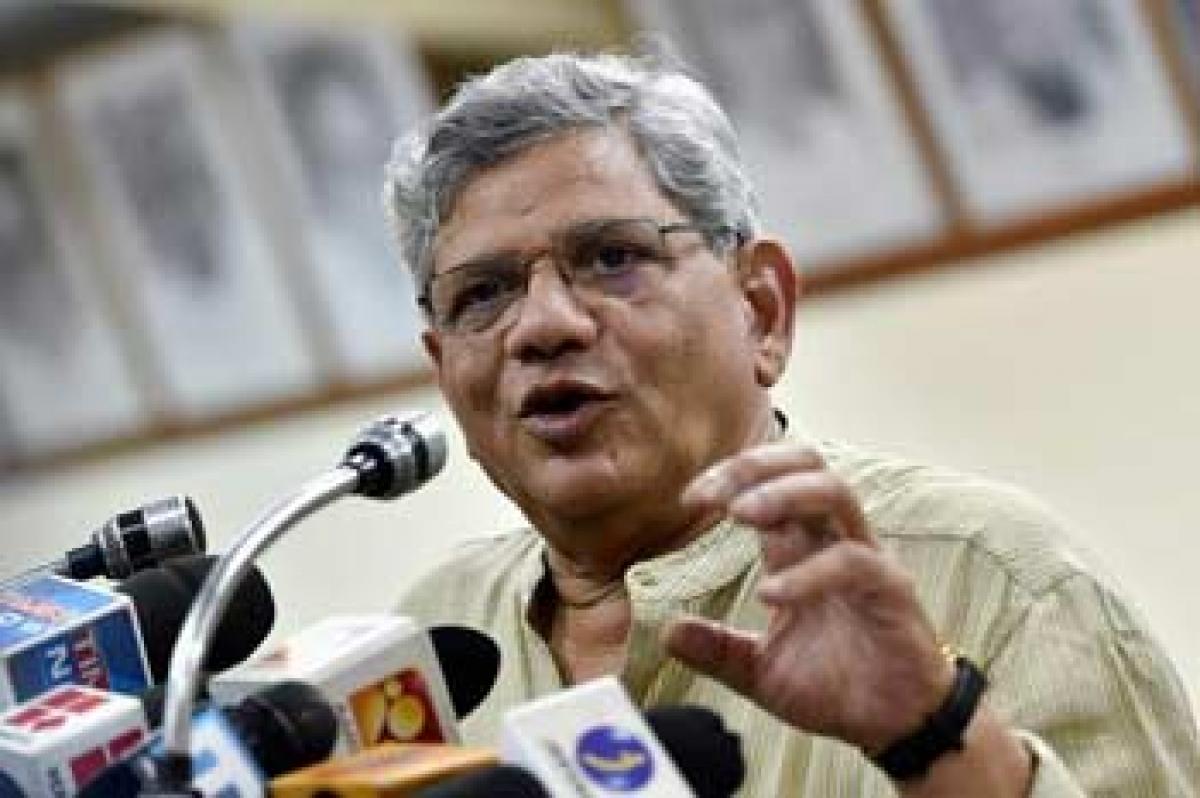Live
- Six Useful Strategies to Control Your Heart During the Pollution Season
- Phalodi Satta Bazar Predicts Close Race in Maharashtra Assembly Election 2024
- Federer Pays Heartfelt Tribute to Nadal Ahead of His Retirement: "An Epic Career"
- Odisha holds successful mega investors roadshow in Singapore
- PGTI Tour: Top stars to fight for honours in Servo Masters Golf
- SC upholds termination of LIC employee for absenting himself without intimation
- ‘Stone me or shoot me, won’t spare anyone,’ says Anil Deshmukh after discharge
- Siddaramaiah, Shivakumar turning Karnataka into Pakistan: K’taka BJP
- Zimbabwe records 70 suspected cholera cases, one death amid new outbreak
- Babri demolition day: No Assembly proceedings in Bengal on Dec 6
Just In

It will not be an overstatement to say that the forthcoming plenum of the Communist Party of India-Marxist (CPM) in Kolkata will decide not only the fate of the party in the coming days but also the existence of the Left politics.
 The actual reasons for the CPM's irrelevance lies in ossification of its ideology, a belief in the largely-rejected theory of the dictatorship of the proletariat, rampant factionalism, corruption and cultivation of mediocrity as was witnessed in West Bengal, the party's biggest laboratory for various experiments
The actual reasons for the CPM's irrelevance lies in ossification of its ideology, a belief in the largely-rejected theory of the dictatorship of the proletariat, rampant factionalism, corruption and cultivation of mediocrity as was witnessed in West Bengal, the party's biggest laboratory for various experiments
It will not be an overstatement to say that the forthcoming plenum of the Communist Party of India-Marxist (CPM) in Kolkata will decide not only the fate of the party in the coming days but also the existence of the Left politics.
That the CPM has been forced to call the plenum 36 years after the last - and theoretically disastrous - one held in Salkia (Howrah/West Bnegal) in 1979, is sufficient proof that the party is in a deep crisis and is groping in the dark for charting a new course.
Still, there is no indication that the party will be able to tide over the follies of the 1979 plenum, which had actually opened the floodgates of entry into the CPM of riff-raff elements that were completely devoid of any kind of initiation in communist thought. Moreover, the CPM is still suffering the legacy of the personalised and less-than-democratic leadership represented by Prakash Karat and his ilk.
In the 21st party congress in Visakhapatnam last April, Sitaram Yechury, the incumbent general secretary, had in fact tried to present a different policy and programme. That his model gained immediate and wide acceptance is a pointer to the need of a reappraisal being felt by the party rank and file.
But the ignorance of the party leadership in unbelievable. P Karunakaran, the CPM leader in the Lok Sabha, is still at a loss to understand why his party is unable to fill up the space created by the continuing weakening of the Congress or why the BJP at the Centre and regional parties in the States are pushing the CPM towards irrelevance. He is also worried about dwindling membership in various frontal organisations of the party.
Karunakaran's statement is a classic case of self-deception, a deadly virus which has affected a great section of the party leadership. The actual reasons for the CPM's irrelevance lies in ossification of its ideology, a belief in the largely-rejected theory of the dictatorship of the proletariat, rampant factionalism, corruption and cultivation of mediocrity as was witnessed in West Bengal, the party's biggest laboratory for various experiments.
The National Election Studies (NES) provides an analytical picture of the Left's electoral standing in present-day India. In the 2014 parliamentary elections, the Left as a whole, which includes not just the CPM but other like-minded parties CPI, Forward Bloc, RSP and the like, won 12 seats (of the Lok Sabha's 543-elected seats) but commanded only 4.8 percent votes of the country - as against 10.6 per cent in 1989.
Since 2004, when the Left bloc had won 62 Lok Sabha seats, its share of votes came down by more than half in 2014. Most importantly, there are no more any signs of Left influence in States like Bihar, Andhra Pradesh and Punjab, where the bloc previously had a good support base.
Barring West Bengal, Kerala and Tripura, the Left is constantly on the retreat. Even in West Bengal, the Left parties are in shambles. This is because the bloc's near absence at the all-India level has told upon its fortunes in West Bengal.
The Left is steadily losing its traditional voter base. So long, this hovered around 7 to 10 per cent of total voters. In 2014, the figure came down to less than three per cent. In 2014, less than five per cent of skilled and service workers voted for them. Among agricultural labourers, less than three percent voted for Left candidates.
This should cause consternation among Left leaders that in West Bengal, the Trinamool Congress had a 10 per cent lead over the Left parties among skilled, semi-skilled urban workers and agricultural labourers. Obviously, the CPM has lost credibility by speaking against neo-liberalism and at the same time following neo-liberal economic measures, whose main proponent was former Chief Minister Buddhadev Bhattacharjee.
By Amitava Mukherjee

© 2024 Hyderabad Media House Limited/The Hans India. All rights reserved. Powered by hocalwire.com







